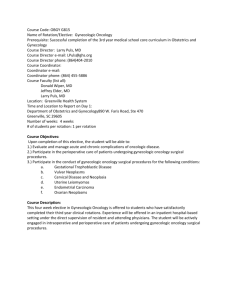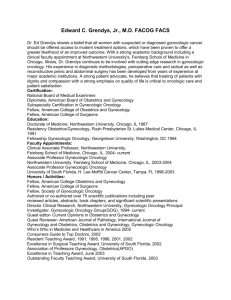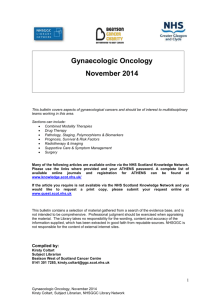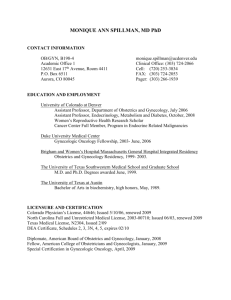January 2015
advertisement
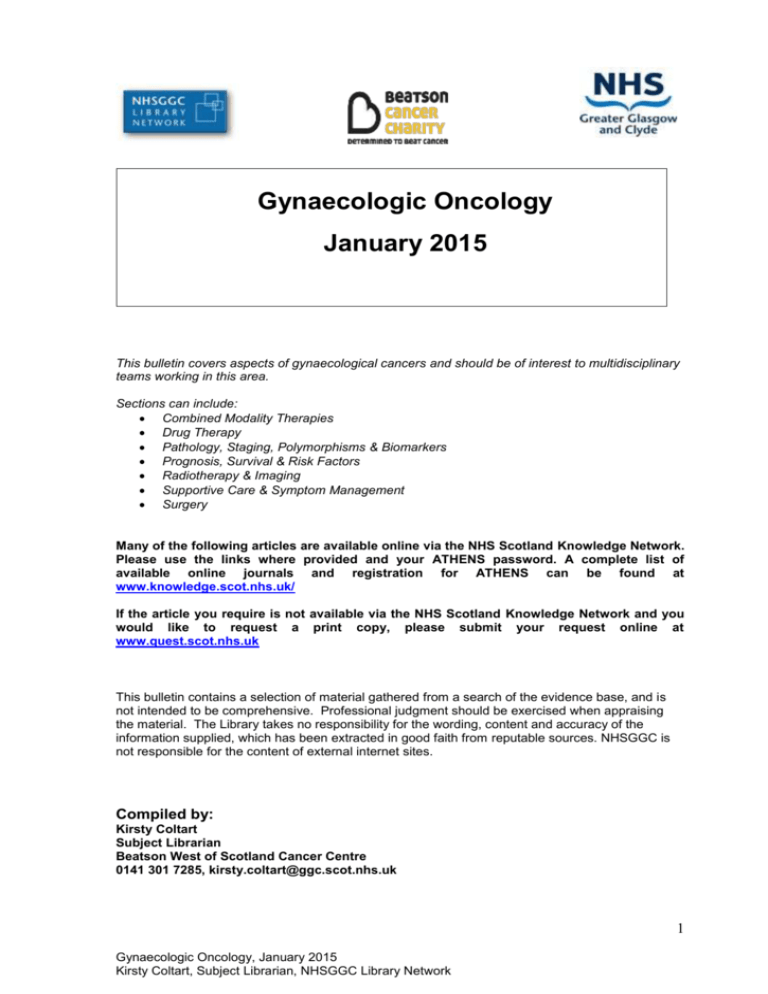
Gynaecologic Oncology January 2015 This bulletin covers aspects of gynaecological cancers and should be of interest to multidisciplinary teams working in this area. Sections can include: Combined Modality Therapies Drug Therapy Pathology, Staging, Polymorphisms & Biomarkers Prognosis, Survival & Risk Factors Radiotherapy & Imaging Supportive Care & Symptom Management Surgery Many of the following articles are available online via the NHS Scotland Knowledge Network. Please use the links where provided and your ATHENS password. A complete list of available online journals and registration for ATHENS can be found at www.knowledge.scot.nhs.uk/ If the article you require is not available via the NHS Scotland Knowledge Network and you would like to request a print copy, please submit your request online at www.quest.scot.nhs.uk This bulletin contains a selection of material gathered from a search of the evidence base, and is not intended to be comprehensive. Professional judgment should be exercised when appraising the material. The Library takes no responsibility for the wording, content and accuracy of the information supplied, which has been extracted in good faith from reputable sources. NHSGGC is not responsible for the content of external internet sites. Compiled by: Kirsty Coltart Subject Librarian Beatson West of Scotland Cancer Centre 0141 301 7285, kirsty.coltart@ggc.scot.nhs.uk 1 Gynaecologic Oncology, January 2015 Kirsty Coltart, Subject Librarian, NHSGGC Library Network General Powell, C.B. (2015). Clinical management of patients at inherited risk for gynecologic cancer. Current opinion in obstetrics & gynecology 27,1:14-22. Ray-Coquard I, Pujade-Lauraine E and Ledermann JA. (2015). New clinical research strategies for rare gynecologic malignancies. Current opinion in obstetrics & gynecology 27,1:53-57. Combined Modality Therapies Ferrandina G, Gambacorta A, Gallotta V, et al. (2014). Chemoradiation with concomitant boosts followed by radical surgery in locally advanced cervical cancer: long-term results of the ROMA-2 prospective phase 2 study. International journal of radiation oncology, biology, physics 90,4:778-785. Otsuki A, Watanabe Y, Nomura H, et al. (2015). Paclitaxel and Carboplatin in Patients With Completely or Optimally Resected Carcinosarcoma of the Uterus: A Phase II Trial by the Japanese Uterine Sarcoma Group and the Tohoku Gynecologic Cancer Unit. International Journal of Gynecological Cancer 25,1:92-97. Rajagopalan MS, Xu KM, Lin JF, et al. (2014). Adoption and impact of concurrent chemoradiation therapy for vaginal cancer: A National Cancer Data Base (NCDB) study. Gynecologic oncology 135,3:495-502. Rose PG, Java JJ, Whitney CW, et al. (2014). Locally advanced adenocarcinoma and adenosquamous carcinomas of the cervix compared to squamous cell carcinomas of the cervix in Gynecologic Oncology Group trials of cisplatin-based chemoradiation. Gynecologic oncology 135,2:208-212. Sueoka K, Umayahara K, Abe A, et al. (2015). Prognosis for endometrial cancer patients treated with systematic pelvic and para-aortic lymphadenectomy followed by platinumbased chemotherapy. International Journal of Gynecological Cancer 25,1:81-86. Tangjitgamol S, Katanyoo K, Laopaiboon M, et al. (2014). Adjuvant chemotherapy after concurrent chemoradiation for locally advanced cervical cancer. Cochrane Database of Systematic Reviews 12,010401. Vargo JA, Boisen MM, Comerci JT, et al. (2014). Neoadjuvant radiotherapy with or without chemotherapy followed by extrafascial hysterectomy for locally advanced endometrial cancer clinically extending to the cervix or parametria. Gynecologic oncology 135,2:190195. Drug & Targeted Therapy Healthcare Improvement Scotland. NICE Single Technology Appraisal Guidance No 284: Bevacizumab in combination with paclitaxel and carboplatin for first-line treatment of advanced ovarian cancer. January 2015. Kumar A, Hoskins PJ and Tinker AV. (2015). Dose-dense Paclitaxel in Advanced Ovarian Cancer. Clinical Oncology (Royal College of Radiologists) 27,1:40-47. Tristram A, Hurt CN, Madden T, et al. (2014). Activity, safety, and feasibility of cidofovir and 2 Gynaecologic Oncology, January 2015 Kirsty Coltart, Subject Librarian, NHSGGC Library Network imiquimod for treatment of vulval intraepithelial neoplasia (RT(3)VIN): a multicentre, open-label, randomised, phase 2 trial. Lancet Oncology 15,12:1361-1368. Tsubamoto H, Takeuchi S, Ito K, et al. (2015). Feasibility and efficacy of intraperitoneal docetaxel administration as salvage chemotherapy for malignant gynaecological ascites. Journal of Obstetrics & Gynaecology 35,1:69-73. Pathology, Staging, Polymorphisms & Biomarkers Bendifallah S, Canlorbe G, Raimond E, et al. (2015). External validation of nomograms designed to predict lymphatic dissemination in patients with early-stage endometrioid endometrial cancer: a multicenter study. American Journal of Obstetrics & Gynecology 212,1:56.e1-56.e7. Kandukuri SR and Rao J. (2015). FIGO 2013 staging system for ovarian cancer: what is new in comparison to the 1988 staging system?. Current opinion in obstetrics & gynecology 27,1:48-52. Kisser A and Zechmeister-Koss I. (2015). A systematic review of p16/Ki-67 immuno-testing for triage of low grade cervical cytology. BJOG: An International Journal of Obstetrics & Gynaecology 122,1:64-70. Kobel M, Madore J, Ramus SJ, et al. (2014). Evidence for a time-dependent association between FOLR1 expression and survival from ovarian carcinoma: implications for clinical testing. An Ovarian Tumour Tissue Analysis consortium study. British journal of cancer 111,12:2297-2307. Pelissier A, Bonneau C, Chereau E, et al. (2014). CA125 kinetic parameters predict optimal cytoreduction in patients with advanced epithelial ovarian cancer treated with neoadjuvant chemotherapy. Gynecologic oncology 135,3:542-546. Schwab CL, English DP, Roque DM, et al. (2014). Past, present and future targets for immunotherapy in ovarian cancer. Immunotherapy 6,12:1279-1293. Shim SH, Lee SJ, Kim SO, et al. (2015). Nomogram for predicting incomplete cytoreduction in advanced ovarian cancer patients. Gynecologic oncology 136,1:30-36. Sun Y, Hu L, Zheng H, et al. (2015). MiR-506 inhibits multiple targets in the epithelial-tomesenchymal transition network and is associated with good prognosis in epithelial ovarian cancer. Journal of Pathology 235,1:25-36. Yang X, Shen F, Hu W, et al. (2015). New ways to successfully target tumor vasculature in ovarian cancer. Current opinion in obstetrics & gynecology 27,1:58-65. Prognosis, Survival & Risk Factors Bjornholt SM, Kjaer SK, Nielsen TS, et al. (2015). Risk for borderline ovarian tumours after exposure to fertility drugs: results of a population-based cohort study. Human Reproduction 30,1:222-231. Frey MK, Philips SR, Jeffries J, et al. (2014). A qualitative study of ovarian cancer survivors' 3 Gynaecologic Oncology, January 2015 Kirsty Coltart, Subject Librarian, NHSGGC Library Network perceptions of endpoints and goals of care. Gynecologic oncology 135,2:261-265. Osann K, Hsieh S, Nelson EL, et al. (2014). Factors associated with poor quality of life among cervical cancer survivors: Implications for clinical care and clinical trials. Gynecologic oncology 135,2:266-272. Waterman L and Voss J. (2015). HPV, cervical cancer risks, and barriers to care for lesbian women. Nurse Practitioner 40,1:46-53. Win AK, Reece JC and Ryan S. (2015). Family History and Risk of Endometrial Cancer: A Systematic Review and Meta-analysis. Obstetrics & Gynecology 125,1:89-98. Radiotherapy & Imaging Bats AS, Frati A, Froissart M, et al. (2015). Feasibility and performance of lymphoscintigraphy in sentinel lymph node biopsy for early cervical cancer: results of the prospective multicenter SENTICOL study. Annals of Nuclear Medicine 29,1:63-70. Gill BS, Kim H, Houser C, et al. (2014). Image-based three-dimensional conformal brachytherapy for medically inoperable endometrial carcinoma. Brachytherapy 13,6:542547. Hou B, Xiang SF, Yao GD, et al. (2014). Diagnostic significance of diffusion-weighted MRI in patients with cervical cancer: a meta-analysis. Tumour Biology 35,12:11761-11769. Iati G, Pontoriero A, Mondello S, et al. (2014). Three-dimensional treatment planning for vaginal cuff brachytherapy: dosimetric effects on organs at risk according to patients position. Brachytherapy 13,6:568-571. Vargo JA, Kim H, Choi S, et al. (2014). Extended field intensity modulated radiation therapy with concomitant boost for lymph node-positive cervical cancer: analysis of regional control and recurrence patterns in the positron emission tomography/computed tomography era. International journal of radiation oncology, biology, physics 90,5:1091-1098. Yap ML, Cuartero J, Yan J, et al. (2014). The Role of Elective Para-aortic Lymph Node Irradiation in Patients with Locally Advanced Cervical Cancer. Clinical Oncology (Royal College of Radiologists) 26,12:797-803. Supportive Care & Symptom Management Brandner S, Muller-Nordhorn J, Stritter W, et al. (2014). Symptomization and triggering processes: Ovarian cancer patients' narratives on pre-diagnostic sensation experiences and the initiation of healthcare seeking. Social science & medicine 119,123-130. Documet P, Bear TM, Flatt JD, et al. (2015). The association of social support and education with breast and cervical cancer screening. Health Education & Behavior 42,1:5564. Farthmann J, Hasenburg A, Weil M, et al. (2015). Quality of life and sexual function in patients with borderline tumors of the ovary. A substudy of the Arbeitsgemeinschaft Gynaekologische Onkologie (AGO) study group ROBOT study. Supportive Care in Cancer 4 Gynaecologic Oncology, January 2015 Kirsty Coltart, Subject Librarian, NHSGGC Library Network 23,1:117-123. Gungorduk K, Ozdemir A, Gokcu M, et al. (2015). Does lubrication of the vaginal speculum reduce pain during a gynecologic oncology examination?. European Journal of Obstetrics, Gynecology, & Reproductive Biology 184,84-88. Guo GH, Yu FY, Wang XJ, et al. (2015). A randomized controlled clinical trial of formalin for treatment of chronic hemorrhagic radiation proctopathy in cervical carcinoma patients. Supportive Care in Cancer 23,2:441-446. Prescott LS, Kidin LM, Downs RL, et al. (2015). Improved compliance with venous thromboembolism pharmacologic prophylaxis for patients with gynecologic malignancies hospitalized for nonsurgical indications did not reduce venous thromboembolism incidence. International Journal of Gynecological Cancer 25,1:152-159. Rithirangsriroj K, Manchana T and Akkayagorn L. (2015). Efficacy of acupuncture in prevention of delayed chemotherapy induced nausea and vomiting in gynecologic cancer patients. Gynecologic oncology 136,1:82-86. Thornton LM, Cheavens JS, Heitzmann CA, et al. (2014). Test of mindfulness and hope components in a psychological intervention for women with cancer recurrence. Journal of Consulting & Clinical Psychology 82,6:1087-1100. Witt J, Elwyn G, Wood F, et al. (2014). Adapting the coping in deliberation (CODE) framework: a multi-method approach in the context of familial ovarian cancer risk management. Patient Education & Counseling 97,2:200-210. Surgery Darai E, Dubernard G, Bats AS, et al. (2015). Sentinel node biopsy for the management of early stage endometrial cancer: Long-term results of the SENTI-ENDO study. Gynecologic oncology 136,1:54-59. Gallotta V, Ghezzi F, Vizza E, et al. (2014). Laparoscopic staging of apparent early stage ovarian cancer: Results of a large, retrospective, multi-institutional series. Gynecologic oncology 135,3:428-434. Grimm C, Harter P, Heitz F, et al. (2015). The Sandwich Technique of Diaphragmatic Stripping or Full-Thickness Resection for Advanced Ovarian Cancer: How to Keep it Short and Simple. International Journal of Gynecological Cancer 25,1:131-134. Lee CK, Lord S, Grunewald T, et al. (2015). Impact of secondary cytoreductive surgery on survival in patients with platinum sensitive recurrent ovarian cancer: Analysis of the CALYPSO trial. Gynecologic oncology 136,1:18-24. Liu H, Lawrie TA, Lu D, et al. (2014). Robot-assisted surgery in gynaecology. Cochrane Database of Systematic Reviews 12,011422. Prescott LS, Aloia TA, Brown AJ, et al. (2015). Perioperative blood transfusion in gynecologic oncology surgery: Analysis of the National Surgical Quality Improvement Program Database. Gynecologic oncology 136,1:65-70. 5 Gynaecologic Oncology, January 2015 Kirsty Coltart, Subject Librarian, NHSGGC Library Network Please note that the journal articles you are accessing are subject to the terms and conditions imposed by the publisher, so there will be a limit on the number of articles an individual may download or print from a single issue of a journal. You can consult your local NHSGGC library with any queries. If you have any questions regarding this or any other library services please contact Library staff – contact details are at the beginning of the bulletin. Sources used for this bulletin: OVID databases, SIGN, NICE, Healthcare Improvement Scotland 6 Gynaecologic Oncology, January 2015 Kirsty Coltart, Subject Librarian, NHSGGC Library Network
